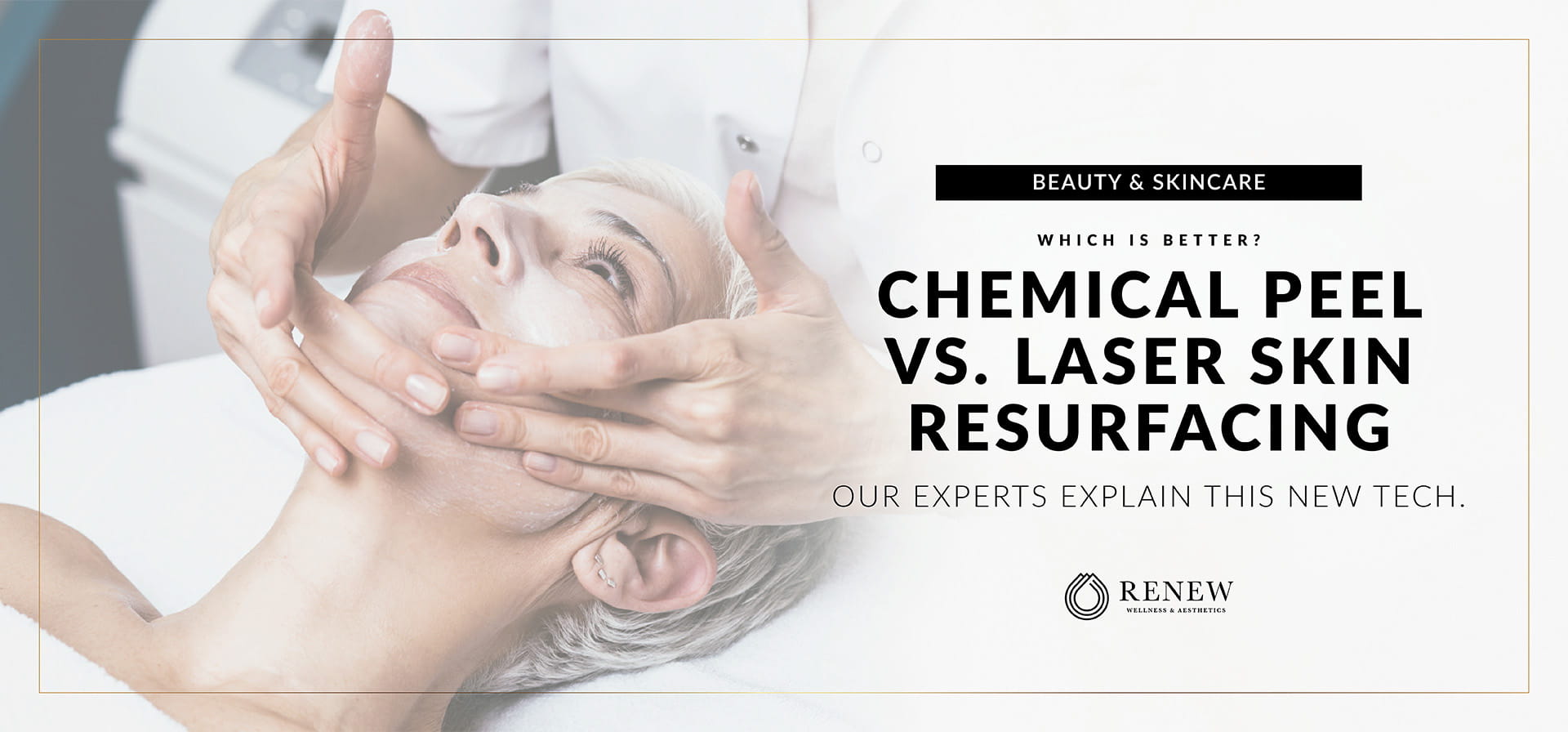Many patients want to know the best and most effective procedures for effectively removing or reducing fine lines, blemishes and acne scars on the face. In OKC, chemical peels are performed quite often but alternatives exist including laser skin resurfacing and the use of new, cutting-edge technology with the Opus Plasma treatment. Both chemical peels and Opus are available at Renew Wellness & Aesthetics in Oklahoma City. Here, we’ll cover the differences between laser skin resurfacing vs. chemical peel OKC treatments? Learn which one is right for you.
Chemical Peel OKC: How Does It Work
The purpose of a chemical peel is to remove the damaged layer of skin (epidermis) and reveal fresh new skin by exfoliating the top layers of dead skin cells. Chemical peels are done with either alpha-hydroxy acid (AHA), which works as an exfoliant, or beta-hydroxy acid (BHA), which has exfoliating properties. Chemical peels vary in strength, depending on the ingredients used (low-strength to high-strength) and how long the peel is left on the face before neutralizing. Typically, chemical peels are applied at certain intervals, anywhere from one week to four weeks.
Laser Skin Resurfacing OKC: How Does It Work
The purpose of laser skin resurfacing, also known as dermabrasion, is to remove the top layer of damaged skin (epidermis) to improve the appearance of fine lines, acne scars and overall complexion.The top layer of skin is removed using an automated machine. It cuts away the damaged skin and protects the delicate new skin underneath by shaving off only the top layers of skin.
There are many benefits of laser skin resurfacing. With advancements in technology, lasers are a popular way to rejuvenate the face and neck and remove unwanted fine lines.
NEW Opus Plasma Technology Preferred Over Lasers
Opus is an advanced skin resurfacing solution available in OKC at Renew Wellness & Aesthetics. It uses cutting edge new plasma technology that can effectively remove or reduce fine lines, blemishes and acne scars. The plasma energy penetrates deep into the skin to help stimulate collagen production without harming new cells as traditional lasers can do. It addresses superficial to complex skin quality concerns.
Moreover, with Opus Plasma treatment, only one session may be necessary for rejuvenating the face and neck. It can be done in less than 30 minutes, with optimal results in 2-3 sessions. No hospital stay, anesthesia or downtime. You can resume normal activities immediately. Plus, it offers benefits like:
1. Better Skin Resurfacing Technology
Opus features a new carbon electrode technology with a plasma-generating anode that delivers a more powerful current to produce a faster cutting action for smoother finishes and greater precision during the resurfacing process.
The Opus technology was first introduced for use in dermatology clinics. Its popularity grew as a result of the outstanding results it produced. The plasma technology is clinically proven to deliver similar results to fractional resurfacing with less discomfort and downtime during treatment with Opus compared to fractional lasers.
2. Optical Precision to Effectively Treat All Skin Types
An essential requirement for laser resurfacing is the ability to control optical parameters during treatment, such as power density and pulse duration. Different skin conditions require different settings. By choosing Opus technology, expect greater accuracy and the most effective treatment.
3. Safety
The Opus laser uses a carbon electrode as its cathode, which provides greater safety. The plasma beam always prevents the anode from touching the skin, and prevents ionized particles from penetrating deep into the skin and causing damage.
Opus Laser Skin Resurfacing vs. Chemical Peel Treatment
Both procedures work by removing the outermost layer of dead cells on the face, which improves the health and appearance of your skin. Chemical peels rely on specific acids that remove layers of skin to reveal new skin. These chemicals only affect the topmost layers of skin. Opus can penetrate deeper into the skin for more effective results. It removes whole layers of skin, not just the topmost layer, which drastically reduces recovery time and side effects.
What Conditions Are Treated With Each Procedure?
Chemical peels are an excellent treatment for rejuvenating older, sun-damaged skin. They are also used for treating fine lines, wrinkles, acne scars and hyperpigmentation. Chemical peels are also the preferred treatment for melasma, a difficult skin condition that causes dark pigmentation of the skin.
Laser resurfacing is more appropriate for patients with signs of aging, such as deep wrinkles or facial scars. It is also beneficial in treating certain types of acne scars that are not suitable for treatment with chemical peels. Noteworthy, the Opus laser has also proven to work well with ALL skin types. ,
Suitability with Skin Types
Chemical peels are best suited for fair or lighter skin types. Some chemical peel treatments are most effective when using multiple sessions. Depending on the type of peel, downtime can be none at all to up to 7 days. It can take up to 3 weeks for patients to notice the final results of the chemical peel treatment.
Opus laser is effective and proven safe with ALL skin types. That is one of the reasons why this laser is so popular among providers and patients at Renew.
Opus Skin Resurfacing Recommended and Available in OKC at Renew
We recommend Opus as the best and safest alternative to traditional laser skin resurfacing or a chemical peel depending your skin condition and aesthetic goals. Schedule a free consultation with Renew Wellness & Aesthetics to discuss your skin type and treatment options.

